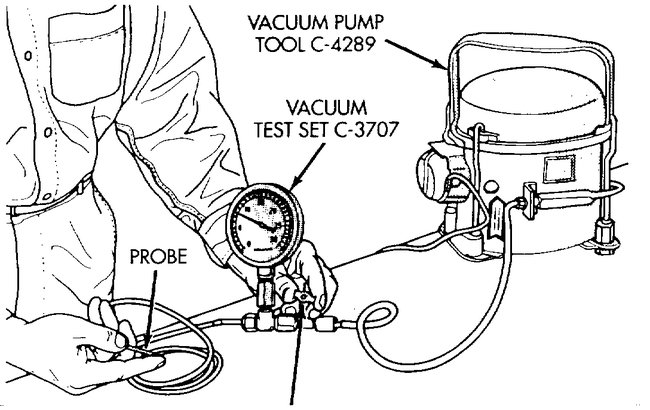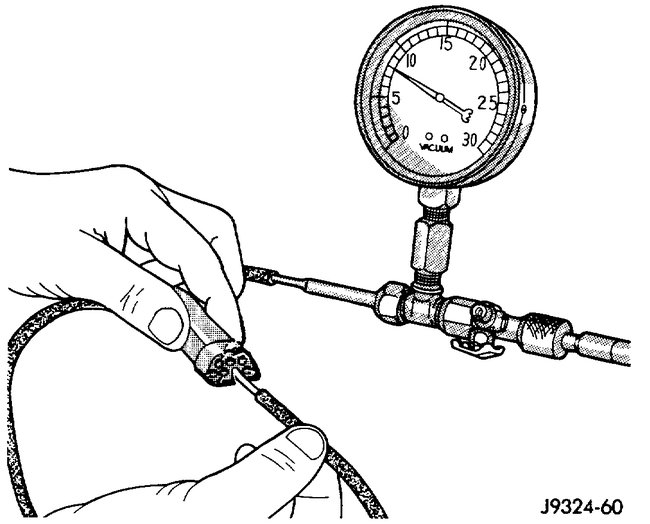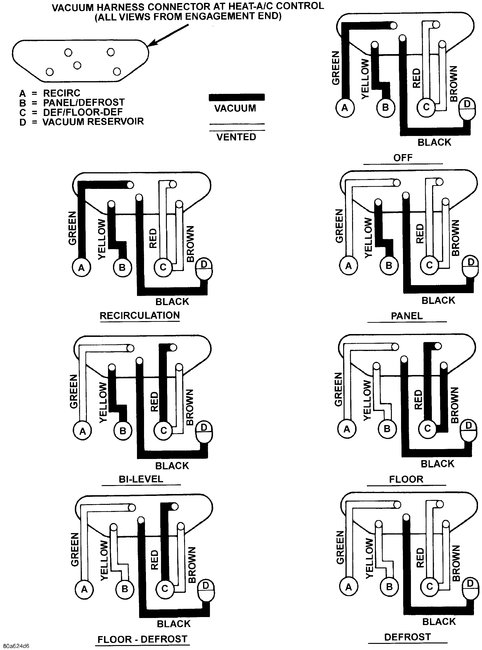Hi and thanks for using 2CarPros.
The air flow directions is changed via engine vacuum. You may have lost engine vacuum to the control or the mode door actuator. Often times on these vehicles, the vacuum supply from the engine is the problem. They use a small plastic vacuum line that gets hard and brittle and is very easy to break.
With that in mind, first inspect vacuum lines which are under the dash as well as under the hood and enter through the firewall. If you find nothing, here are the directions for identifying where the problem is located.
____________________________________________
VACUUM SYSTEM TESTING
Fig 9 Adjust Vacuum Test Bleed Valve
See picture 1
VACUUM SYSTEM
Vacuum control is used to operate the mode doors in the heater-only and heater-A/C housings. Testing of the heater-only and heater-A/C mode control switch operation will determine if the vacuum, electrical, and mechanical controls are functioning. However, it is possible that a vacuum control system that operates perfectly at engine idle (high engine vacuum) may not function properly at high engine speeds or loads (low engine vaccine). This can be caused by leaks in the vacuum system, or a faulty vacuum check valve.
A vacuum system test will help to identify the source of poor vacuum system performance, or vacuum system leak Before starting this test, stop the engine and make certain that the problem isn't a disconnected vacuum supply tube at the engine intake manifold vacuum tap or the vacuum reservoir.
Use an adjustable vacuum test set (Special Tool C-3707) and a suitable vacuum pump to test the heater-A/C vacuum control system. With a finger placed over the end of the vacuum test hose probe, adjust the bleed valve on the test set gauge to obtain a vacuum of exactly 27 kPa (8 in. Hg.). Release and block the end of the probe several times to verify that the vacuum reading returns to the exact 27 kPa (8 in. Hg.) Setting. Otherwise, a false reading will be obtained during testing.
VACUUM CHECK VALVE
1. Remove the vacuum check valve. One valve is located in the vacuum supply tube (black) at the intake manifold tap on the right side of the engine. The second valve is located next to the tee fitting in the (black) vacuum supply tube near the dash panel in the engine compartment.
2. Connect the test set vacuum supply hose to the heater (natural color) side of the valve. When connected to this side of the check valve, no vacuum should pass and the test set gauge should return to the 27 kPa (8 in. Hg.) Setting. If OK, go to step 3. If not OK, replace the faulty valve.
3. Connect the test set vacuum supply hose to the engine vacuum (black color) side of the valve. When connected to this side of the check valve, vacuum should flow through the valve without restriction. If not OK, replace the faulty valve.
HEATER-AIR CONTROLS
1. Connect the test set vacuum probe to the heater-A/C vacuum supply (black) tube in the engine compartment. Position the test set gauge so that it can be viewed from the passenger compartment.
2. Place the heater-A/C mode control switch knob in each mode, one at a time, and pause after each selection. The test set gauge should return to the 27 kPa (8 in. Hg.) Setting shortly after each selection is made. If not OK, a component or vacuum line in the selected mode's vacuum circuit has a leak. See Locating Vacuum Leaks.
CAUTION: Do not use lubricant on the switch ports or in the holes in the plug, as lubricant will ruin the vacuum valve in the switch. A drop of clean water in the connector plug holes will help the connector slide onto the switch ports.
Fig 10 Vacuum Circuit Test
See picture 2
LOCATING VACUUM LEAKS
1. Disconnect the vacuum connector from the back of the heater-A/C mode control switch on the control panel.
2. Connect the test set vacuum hose probe to each port in the vacuum harness connector, one at a time, and pause after each connection. The test set gauge should return to the 27 kPa (8 in. Hg.) Setting shortly after each connection is made. If OK, replace the faulty mode control switch. If not OK, go to step Step 3.
Fig 11 Vacuum Circuits
See picture 3
3. Determine the vacuum line color of the vacuum circuit that is leaking. To determine the vacuum line colors, refer to the Vacuum Circuits chart.
4. Disconnect and plug the vacuum line from the component (fitting, actuator, valve, switch, or reservoir) on the other end of the leaking circuit. Instrument panel disassembly or removal may be necessary to gain access to some components.
5. Connect the test set hose or probe to the open end of the leaking circuit. The test set gauge should return to the 27 kPa (8 in. Hg.) Setting shortly after each connection is made. If OK, replace the faulty disconnected component. If not OK, go to Step 6.
6. To locate a leak in a vacuum line, leave one end of the line plugged and connect the test set hose or probe to the other end. Run your fingers slowly along the line while watching the test set gauge. The vacuum reading will fluctuate when your fingers contact the source of the leak. To repair the vacuum line, cut out the leaking section of the line. Then, insert the loose ends of the line into a suitable length of 3 mm (1/8-inch) inside diameter rubber hose.
___________________________________________
Let me know if this helps or if you have other questions.
Take care,
Joe
Images (Click to make bigger)
SPONSORED LINKS
Friday, April 23rd, 2021 AT 11:55 AM






